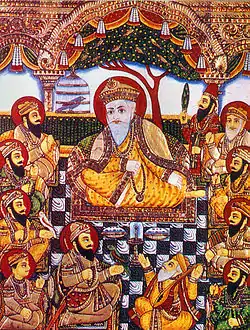Bhai Bala
Bhai Bala (Punjabi: ਭਾਈ ਬਾਲਾ 1466–1544), born in Talvandi Rai Bhoi (now called Nankana Sahib in Pakistan),[1][2] was a childhood friend and lifelong companion of Bhai Mardana and Guru Nanak. According to the Bhai Bala Janam Sakhi's, he traveled with Guru Nanak and Bhai Mardana on all of their great journeys around the world including China, Mecca, and around India.He is a great Sikh. He supposedly died in Khadur Sahib, in his late 70s, in 1544. [1][3]

Bhai Bala's existence
There has been considerable discussion as regards to Bhai Bala's existence, particularly within the Sikh academic field. The reasons for this are:
Bhai Gurdas, who has listed all Guru Nanak's prominent disciples (in his 11th Var), does not mention the name of Bhai Bala (this may be an oversight, for he does not mention Rai Bular either). However Bhai Mani Singh's Bhagat Ratanwali, which contains essentially the same list as that by Bhai Gurdas, but with more detail, also does not mention Bhai Bala. There are a number of other anomalies, which Dr. Kirpal Singh has explicated in his Punjabi work 'Janamsakhi Tradition.'[4][5]
Professor Surjit Hans also notes that the only role of Bhai Bala was to denigrate the name of Nanak and that Guru Nanak prophesizes about a greater bhagat (Hundal) to come.
Also in the Bhai Bala Janamsakhi are several language inconsistencies. For example, the Sikh salutation 'Waheguru Ji Ki Fateh' is used in the Bala Janamsakhi, however this term only gained currency during the reign of Guru Gobind Singh.
See also
References
- McLeod, W.H., Guru Nanak and the Sikh Religion. Oxford, 1968.
- A Gateway to Sikhism | Early Gursikhs: Bhai Bala Ji - A Gateway to Sikhism
- Max Arthur Macauliffe, 1909
- Singh, Dr Kirpal, Janamsakhi Tradition (An Analytical Study). Singh Brothers, 2004.(page 10)
- Dr. Kirpal Singh. "Janamsakhi Tradition – An Analytical Study" (PDF). Retrieved 8 September 2012.